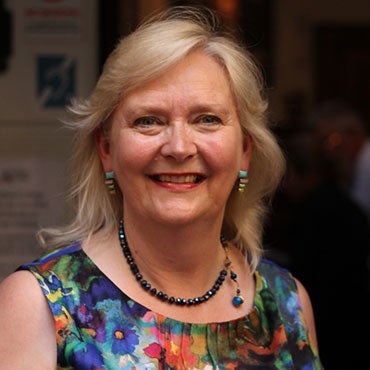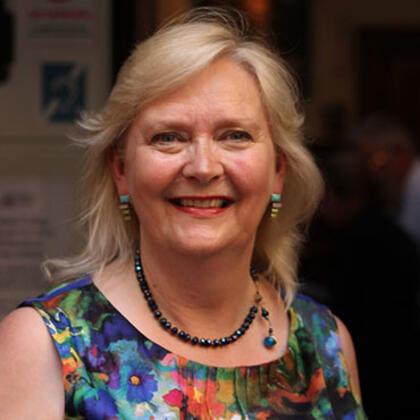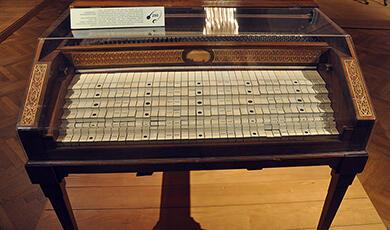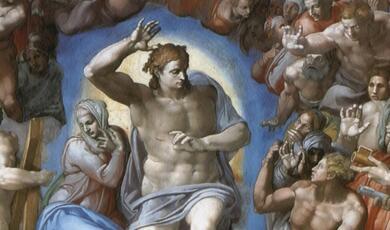London Fog and the Impressionists
Share
- Details
- Text
- Audio
- Downloads
- Extra Reading
The lecture will explore different artistic representations of London Fog by artists such as W L Wyllie, Monet, Whistler and the Japanese artist Yoshio Markino. Viewed largely as a nuisance by London-born artists, it took foreign artists to make London Fog more acceptable.
Part of the Mondays at One series on Artists in London
Download Text
27 June 2016
London Fog and the Impressionists
Dr Christine Corton
The art critic and historian John Ruskin (1819-1900) observed in his old age that “had the weather when I was young been such as it is now, no book such as ‘Modern Painters’ ever would or could have been written.” “London fog”, he noted, where “the air is pure, though you choose to mix up dirt with it, and choke yourself with your own nastiness.” Many English artists, especially those based in London, felt the same about the murky atmosphere as Ruskin did. David Roberts (1796-1864), a Fellow of the Royal Academy, acknowledged the problem in 1862: “I break new ground with my ‘London From the Thames’; but I have still two weeks, and if the weather keeps from fog I shall be all right and ready.” Luke Fildes in October 1880 (1844-1927) registered his unhappiness with the atmosphere in the strongest terms: “We have endured and still endure the most awfully dark and hopeless winter that has ever been known in London, consequently the civilized globe. We had uninterrupted heavy fog for 5 consecutive days last week … it is too dark for painting and so dense that we have had to burn gas to get our meals by … Nobody is doing any work except a few at Hampstead.” For a painter who was literally scraping a living from his work, the lack of clear light, and the need to spend money burning gas or candles during the day was catastrophic. Wealthier artists tried to circumvent the problem by having winter studios built which were equipped with floor-to-ceiling windows but even this did not help. Most simply went to the south of France or even the Holy Land during the winter months.
Frederick Leighton (1830-96), one of the most popular of all Victorian painters and a President of the Royal Academy, felt so incensed about the fog problem that he used his position in the public eye to make a speech on the subject of London fog at the Lord Mayor’s dinner in 1882:
We are further and especially attacked and paralysed in the heart and centre of our intellectual activity; for we live by the suggestive imitation and presentment of that which is revealed to us by light, - and by light alone- and made lovely by its splendour. To us, therefore, the quenching of light, the blotting out of colour is an approach to the drying up of the very life springs from which we are fed and set in motion … Many a brother painter must regret with me the interminable hours, days and weeks of enforced idleness spent in the continuous contemplation of the ubiquitous yellow fog, depressing the spirits all the more.
“As regards colour and light,” declared the Art Journal in 1888 in a discussion of painting in London, “there is the standing grievance of the smoke … The blackness that comes from soot has neither depth nor lustre; it is opaque, gritty shallow, grey-a denial of everything that the colourist loves.”
The Royal Academy viewed history painting as the most important genre, creating dignity as well as showing patriotism. Often Landscape artists combined landscape with an historical scene, frequently harking back to the classical world to show an affinity with the achievements of Great Britain as a supreme power. As Nadel and Schwarzbach point out:
Traditional conventions, and often outmoded ones were extremely powerful in all the arts in the century and those that governed the graphic arts did not with ease admit urban subjects. Such subjects tended to be unruly, disordered, dirty, and unpleasant.
Mechanical achievements had been celebrated in art and seen as enhancing the landscape. Views of Coalbrookdale on the Severn were a rich source for many early nineteenth-century artists, including Turner. But these paintings celebrated the energy of the blazing furnaces as sublime images, not the smoke that was produced as a side product before the fire really got going. The great engineers and industrial architects of the late eighteenth and early nineteenth centuries were esteemed not only as public benefactors, but also as true artists whose works enhanced the landscape. By the 1840s however the impact of industry on the landscape came to be seen in a more negative light and as Klingender remarks: ‘The alliance that had grown up in the later eighteenth century between science and art had a common foundation of humanism. When political economy abandoned the humanities standpoint for the defense of property the link between science and art was broken.’ In addition, by this time, many buyers were prospering manufacturers, industrialists, part of the new upper-middle class, who preferred clear skies and clean lines.
Turner, not surprisingly painted one of the earliest pictures of London’s fog in this 1835 painting The Thames above Waterloo Bridge. Turner as a true born Londoner is advertising his familiarity with London’s air problem by putting smoke and atmospheric pollution at its centre. Turner never bothered to finish his painting presumably because he could see that there would be no ready market for it.
The acceptable portrayal of art is revealed in a painting by John O’Connor (1830-1889) who exhibited his painting of The Embankment in 1874. It still very much reflects the style of Canaletto, O’Connor even positioned himself on the terrace of Somerset House to echo Canaletto’s painting of the same view some 130 years before. The painting is a celebration of the newly completed Embankment.
Another successful painter of London was David Roberts, mentioned earlier in this paper, his undertook a series of views of London in the 1860s which were criticized in Blackwood’s Magazine for the absence of fog or smog from Roberts’ visions of London, He wondered if the painter had confused the city with Venice, while a writer for the Saturday Review lamented that “we fail to recognise, whether in figures or shipping, the traffic that is really peculiar to our own river. In point of fact, Mr Roberts has treated us to a foreign importation.” But Roberts had a wealthy patron, Charles Lucas, who owned the contracting firm which built the Metropolitan and District lines. Roberts would not have risked offending such a loyal patron who bought all of his paintings.
Worst was to follow for another English artist who wanted to portray the smoky, frequently fogbound city that people experienced in their daily lives. William Wyllie (1851-1931) aroused fierce criticism for his disagreeable representation of London in his painting London from the Monument. It began well by being ‘honoured with a position on the line’ when it was exhibited at the Royal Academy in 1870.
The painting did not sell, and received damning criticism from the Art Journal of that year: ‘The city seems as a vast pandemonium. The picture is undoubtedly clever, and yet disagreeable.’ Worst was to follow when, according to Mrs Wyllie, a picture dealer known as “little T” came into the Wyllie’s bedroom where the painting was hung, “He looked at the picture for some time and said, “’what d’ye want for it?’ Bill named his price. T. said, ‘I’ll tell you what I value it at.’ He took out his penknife, opened it, reached over me, and stuck the blade right into the middle of the canvas.’
It was foreign artists who made the difference between seeing the foggy atmosphere of London as a nuisance and seeing the potential of painting light through the fog and mist within the urban setting. James McNeil Whistler (1834-1903) arrived in London in 1859. John House suggests: ’Beginning in the early 1860s, mist and fog became an increasingly central element in Whistler’s paintings of the Thames.’ These paintings were not intended to highlight the atmosphere in problematic terms and relate it to problems of air pollution and increasing industrial waste, they reflected his wish to aestheticise the visual experience. Battersea Reach from Lindsey Houses (1864-71) is the view from Whistler’s house in what is now Cheyne walk, Chelsea and it shows the Thames smothered by fog. But it faced the same fate as others on this subject, it was rejected by the Academy and as with Turner’s earlier work, it was never finished and certainly never sold.
In 1881 Whistler started this view of central London in the fog. Called Nocturne in grey and gold – Piccadilly (1881-3), it took only two years to complete. The contemporary Londoner would have recognized a scene all too familiar.
It is a picture that evokes both mystery and fear. The background appears to be an empty chasm devoid of form which we know must be there. The precise way the street light and the brighter windows are painted give the overall impression of these looming towards the viewer, as in fact, they often seemed to on a foggy night. The horses and the people are ghostly silhouettes whose form appears to be dissolving before our eyes. The people on the top of the carriage in the foreground appear to be floating on air. The eeriness and the ghostliness are further enhanced by the flares of the linklighters. It reveals a world disappearing into formlessness beneath the weight of the yellow-grey fog. The Kensington News described the painting as ‘one of the most enchanting little atmospheric gems one could well desire to possess’. In spite of this, it failed to find an immediate buyer with a desire to possess it, when it was exhibited in Bond Street that May.
It was Whistler’s aim to aestheticize London fog. As he said in his Ten O’Clock Lecture of 1885:
And when the evening mist clothes the riverside with poetry, as with a veil, and the poor buildings lose themselves in the dim sky, and the tall chimneys become campanili, and the warehouses are palaces in the night and the whole city hangs in the heavens, and fairy-land is before us – then the wayfarer hastens home; the working man and the cultured one, the wise man and the one of pleasure, cease to understand, as they have ceased to see, and Nature, who, for once, has sung in tune, sings her exquisite song to the artists alone.
For the artist, the veil disguises the poverty, commercialism and squalor of London, transforming it into a magical world wiping out all social and moral distinctions in blinding them to the aesthetic possibilities of a natural phenomenon. Whistler does not acknowledge, in this passage at least, that fog could be partly man-made. Whistler found the quality of movement within a foggy day enchanting.
Another great painter of London fog was one of the leaders of the Impressionist movement in art, Claude Monet (1840–1926). It was his work Impression, Sun Rising (1872) which led a critic to coin the word for the movement. Monet’s growing focus on the effects of atmosphere and light found an ideal subject in the Thames, shrouded in a winter fog, which he initially encountered when he fled Paris after the outbreak of the Franco-Prussian War in 1870. On a later visit, in order to study the impact of the changing atmosphere of London, he took a room on the sixth floor of the Savoy Hotel from September to November 1899, re- turning to the hotel twice more in order to complete his work. During his second stay he was unable to use the same room and had to content himself with a room with a similar view on the fifth floor. From here he painted Charing Cross Bridge and Waterloo Bridge, producing a total of thirty-four and forty-one paintings respectively of each bridge. He used a room in St. Thomas’s Hospital to paint a series of pictures of the Houses of Parliament, of which nineteen examples are known to have survived.
Monet started many sketches at this time; but the effect that so im- pressed him—the changing colours of the light and atmosphere—proved an immense problem, as the changes were so rapid that it was difficult to finish any one painting at a time. So he started on several canvases and went back to them when he figured the light was similar. In this way he started over a hundred paintings, many of which he destroyed or never finished. In the end he took them back to his studio in Giverny to complete them. In 1903 he informed Paul Durand-Ruel, his Parisian art dealer, “I cannot send you a single painting of the London series as it is absolutely necessary for the work I am doing to have them all in front of me and, to be honest, not a single one is completed yet.” Monet did not want each to illustrate a state of the atmosphere individually, standing alone, but wanted to see them all in continuity with each other. His stay in London resulted in the largest series of paintings that he had yet produced. From this period he exhibited thirty-seven paintings in 1904, many showing the same London scenes in different atmospheric conditions but most portraying them through a veil of fog. Many of the paintings have the word “effet” in the title to indicate the impression of the changing atmosphere on the artist’s eye.
He once wrote, “When I got up, I was terrified to see that there was no fog, not even the least trace of a mist; I was in despair, it seemed all my canvases were going for naught, but then little by little, as the fires were lit, the smoke and the mist returned.” Industrial smoke also enthralled him, and he complained of its absence on Sundays: “What a dreary day this damned English Sunday is. Nature feels the effects, everything is dead, no trains, no smoke, no boats, nothing to in- spire me.”
Monet may have chosen such well-known objects as the Houses of Parliament or the bridges spanning the Thames in order to play with the preconceptions of the viewer and to suggest the transience of apparently fixed impressions dissolving time as well as space. The changing nature of the fog imposed constantly varying impressions on the artist’s, and hence the viewer’s, eye. Monet returned to France in 1901 continued to work on the London series for three years, even working from a photograph. A practice that the art seller Durand-Ruel criticized but, as Monet replied: ‘Whether my paintings were done from nature or not, that is nobody’s business and is not important. The result is everything.’
© Dr Christine Corton, 2016
Part of:
This event was on Mon, 27 Jun 2016
Support Gresham
Gresham College has offered an outstanding education to the public free of charge for over 400 years. Today, Gresham College plays an important role in fostering a love of learning and a greater understanding of ourselves and the world around us. Your donation will help to widen our reach and to broaden our audience, allowing more people to benefit from a high-quality education from some of the brightest minds.


 Login
Login







